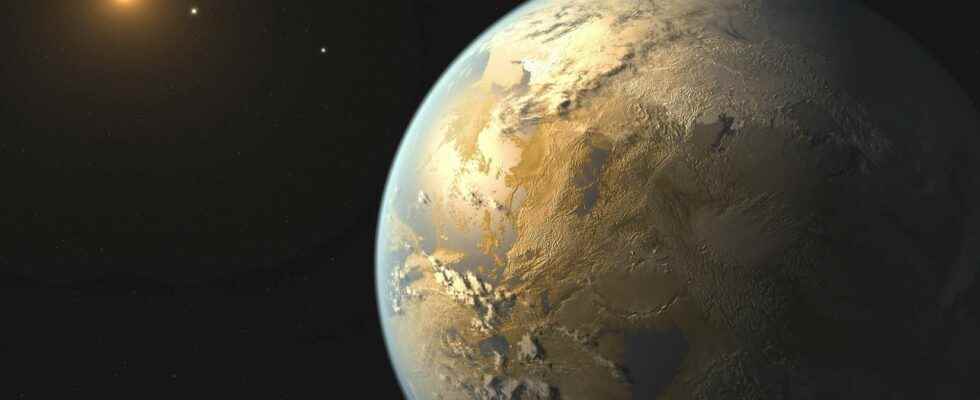You will also be interested
[EN VIDÉO] Interview: what is an exoplanet? The question of exoplanets is very old in astronomy. Their existence was first attested indirectly in the 1990s. Futura-Sciences met Jean-Pierre Luminet, a renowned astrophysicist, so that he could speak to us in more detail about this fascinating subject.
China plans to expand its space program and could decide in June to give its fire green to the creation of a space observatory dedicated to the search forexoplanets and Earth-like planets. Called Earth 2.0, the goal of this observatory is to discover planets similar to Earth in size, mass and constitution, and especially evolving in the habitable zone of their star. These planets, which are supposed to have the right conditions for water in the state liquid exists and would therefore be habitable, or even inhabited, are called Earth 2.0, or Earth 2.0, in English. Hence the name of the Chinese project.
If more than 5,000 exoplanets have been brought to light since the discovery of the first of them (51 Pegasi b) in October 1995 by Michel Mayor and Didier Queloz, today none corresponds to the definition of an Earth 2.0. Indeed, despite the progress of technology and improved observation techniques, with the telescopes current it is extremely difficult to find small planets similar to Earth. For now, the only telluric planets discoveries evolving in zones of habitability are larger than the Earth. And so, the chances of discovering life there are still quite small.
For the moment the only telluric planets discovered evolving in zones of habitability are larger than the Earth
Earth 2.0 is a satellite that will use seven small telescopes that could be launched in 2026, just four years after its selection. It has many similarities to the European Space Agency’s Plato mission, which is also scheduled for launch in 2026. But, while Earth 2.0 is made up of seven telescopes, Plato will use 34. Jean-Schneider, astrophysicistCNRS research director emeritus at the Paris-Meudon Observatory, ” this schedule is very ambitious compared to Plato, the launch of which is scheduled for 2026, 12 years after its selection in 2014 “. Admittedly, the Chinese observatory seems technically less complex than Plato, but all the same, the ” to achieve in just four years is very ambitious “.
Until the project has been approved by the Chinese Academy of Sciences, which door, the information is rather succinct. What is known is that it should work for at least four years. Six of its seven telescopes will point in the direction of the constellations of Cygnus and Lyra, the same region of the sky observed from 2009 to 2018 by the Nasa’s Kepler telescope which had among its objectives, that of discovering some of these famous Earth 2.0. The choice to observe this region is explained by the very large amount of data acquired by Kepler.
The satellite’s seventh telescope will search for planets by micro-lensing. This is a new observation technique thatEuclid (ESA), launching in 2023, and Plato will also implement. The Chinese will therefore not be the first to use it. This search for planets by micro-lensing will mainly focus on wandering planetsthat is to say, which wander in space without revolving around any particular star.
To detect exoplanets, Earth 2.0 will use the so-called transit planetary scale which is based on the measurement of small periodic variations of the brightness of a star when a planet passes in front of it. It is expected to observe some 1.2 million stars including stars darker and more distant than the satellite Tess (Transiting Exoplanet Survey Satellite) of the Nasawhich studies bright stars near Earth.
Discover planets very similar to Earth
Unsurprisingly, this observatory will surpass Kepler in sky observation capability. An advance that can be explained by advances in technology and science. Remember that Kepler was designed in the early 2000s, more than twenty years ago. Earth 2.0 will be 10 to 15 times more powerful than Kepler. Surprisingly, the Chinese readily compare Earth 2.0 to Kepler and rightly announce that it will surpass it, but they are careful not to compare it to Plato “ which itself will be more powerful than Kepler and Tess, and presumably more capable than Earth 2.0,” emphasizes Jean Schneider, also a member of the Plato team.
Despite Kepler’s failure to discover Earth 2.0, the Chinese are quite optimistic and are convinced that they could discover a dozen during the four years of the duration life of their observatory. It would obviously be a remarkable performance but well below Plato’s promises. Indeed, it is expected that Plato will discover a few thousand planets, including a thousand telluric exoplanets similar to Earth, including a hundred in the habitable zone of their star.
Whether these Earth 2.0 planets discovered by Earth 2.0 or Plato are inhabited is a different matter. For Jean Schneider, in theory it would be ” possible to detect a form of life on these planets using the technique of analyzing the spectral signature of the observed exoplanet “. For example, a proof of exoplanetary life is ” expected via the IR spectral study, sensitive to the presence of ozone, linked to the presence ofoxygenand therefore to a particular chemistry which is at least in one known case conducive to life “.
Interested in what you just read?
